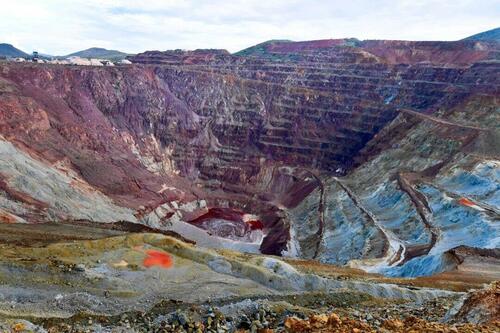US Proposes Adding Copper, Potash, 4 Others To Critical Minerals List
Authored by John Haughey via The Epoch Times,
The United States Department of Interior is proposing to add six “mineral commodities” to the list of critical minerals as part of the Trump administration’s effort to incentivize domestic production and processing of metals, minerals, and rare earth elements vital to the nation’s economy and national defense.
Potash, silicon, copper, silver, rhenium, and lead are recommended by the U.S. Geological Survey (USGS) for inclusion on the list, which will be formally posted in the Federal Register on Aug. 26.
Arsenic and tellurium, defined as critical minerals on the USGS’s 2022 Critical Minerals List, are recommended for removal from the draft list posted Aug. 25.
If adopted as proposed after a 30-day public comment period, the nation’s 2025 Critical Mineral List will expand to 54 “mineral commodities” from 50 three years ago and 35 in 2018.
Of those 50 minerals cited as critical by the USGS in 2022, China-based processors dominate the global market in producing at least 30, an increasingly urgent concern.
Since 2023, China has imposed restrictions on strategic materials exported to the United States, including gallium, germanium, antimony, graphite, and tungsten.
“The U.S. relies heavily on imports of critical minerals and their derivative products that are essential for the manufacturing, energy, transportation, and national security sectors,” National Mining Association Executive Vice President Katie Sweeney said in her May 21 testimony before the House Energy and Commerce Committee.
“Unfortunately,” she said, “for some of these minerals, the U.S. is dependent on a small group of countries—both allies and geopolitical adversaries. This presents considerable risk in supply chain disruptions for many reasons including … foreign government policies creating outright competitive disadvantages for U.S. companies.”
To reduce reliance on imported critical minerals, President Donald Trump issued a March executive order requiring federal agencies to help expedite projects by streamlining permitting, opening more public lands for mining, and including critical mineral development under the regulatory auspices of the Defense Production Act.
In the past month, the Energy Department announced that it would shift $1 billion from programs established under 2021’s Bipartisan Infrastructure Law and 2022’s Inflation Reduction Act into funding critical mineral projects. According to Reuters, the Trump administration is also considering reallocating at least $2 billion from the 2022 CHIPS and Science Act into critical mineral mining and processing.
“President Trump has made clear that strengthening America’s economic and national security means securing the resources that fuel our way of life,” Interior Secretary Doug Burgum said in a statement accompanying the USGS draft list.
A 2017 executive order issued by Trump requires the USGS, the Department of Energy, the Department of Defense, and the Department of the Interior to analyze and address the vulnerability of domestic supply chains for critical minerals. The Energy Act of 2020 requires the list to be updated every three years.
The 2025 three-year update was developed using a new methodology that assessed potential effects of more than 1,200 “trade disruption scenarios” involving 84 mineral commodities on 402 individual industries and the U.S. economy overall.
The modeled economic impacts were then weighted by the probability of the disruption scenario, the USGS said. “Probability weighting combines the likelihood of a scenario occurring with the impact of the scenario,” the survey said in an Aug. 25 methodology explainer.
USGS acting Director Sarah Ryker said the proposed new draft list reflects “advances in forecasting potential mineral supply chain disruptions” that provide “a next generation risk assessment that can be used to prioritize securing the nation’s mineral supply chains.”
“Minerals-based industries contributed over $4 trillion to the U.S. economy in 2024,” she added, “and with this methodology we can pinpoint which industries may feel the greatest impacts of supply disruptions and understand where strategic domestic investments or international trade relationships may help mitigate risk to individual supply chains.”
The top 10 mineral commodities, in descending order by the estimated probability-weighted impact of supply disruptions on the U.S. economy, are samarium, rhodium, lutetium, terbium, dysprosium, gallium, germanium, gadolinium, tungsten, and niobium.
The Energy Act of 2020 gives the Interior secretary broad authority to designate additional minerals for inclusion on the Critical Minerals List.
Metallurgical coal and uranium are cited by the Trump administration as preferred entries onto the list, and “the USGS intends to analyze and provide information to the secretary on the potential for including them on the 2025 List of Critical Minerals,” the agency said.
The Interior Department encouraged Americans to make their views known during the 30-day comment period.
“Public comment is specifically welcomed on inclusion of metallurgical coal and uranium, whether other minerals should be added,” it said.
The proposed list “provides a clear, science-based roadmap to reduce our dependence on foreign adversaries, expand domestic production and unleash American innovation,” Burgum said.
“By working with industry and state partners,” he concluded, “we are ensuring that the minerals powering our energy, defense, and technology supply chains are produced and processed in the United States by American workers.”
Tyler Durden
Tue, 08/26/2025 – 19:15
Source link


















